-
Written by Christopher Van Mossevelde
Head of Content at Funnel, Chris has 20+ years of experience in marketing and communications.
Is DashThis a good reporting tool for growing marketing teams? DashThis is easy to set up but has limited features and functionality. These DashThis alternatives give marketing teams more flexibility with data, dashboards and client reporting.
DashThis is a solid option for marketers who want to spin up quick, no-code dashboards. But once your reporting needs grow — more clients, more platforms, more metrics — it can feel limiting. Custom calculations are tough. Exports are rigid. And data that doesn’t fit the template? You’re out of luck.
That’s why teams eventually start looking for something more flexible. Whether you're managing multiple ad accounts, blending web and CRM data or relying on advanced measurement tools, DashThis may not be a great fit.
This page breaks down the best DashThis alternatives available today. We cover what each tool does well, who it’s best suited for and what to watch out for. Whether you’re a performance marketer, agency lead or data analyst tired of making things work manually, there’s a better fit out there.
Before we dive into alternatives, let’s take a quick look at what DashThis offers and where it starts to fall short for growing teams.
What is DashThis?
DashThis is a reporting platform built for marketers who need to create dashboards and send updates without a steep learning curve. It’s especially popular with small businesses and digital marketing agencies that want to automate recurring reports.
Users can build dashboards using prebuilt templates and connect to major marketing platforms like Google Ads, LinkedIn Ads, Facebook and Google Analytics. Data updates automatically once sources are set up.
Useful features include:
- Automated report sharing
- White label options for client-facing reports
- Custom date filters and basic interaction controls
- Export options (PDF, Google Sheets, CSV file)
- Unlimited dashboards and users on select plans
DashThis works well for straightforward reporting needs — when you're mostly sharing top-level KPIs and campaign performance with clients or internal teams. But it has a few limits in terms of functionality that can be problematic for growing teams. There’s no support for blending data across platforms, creating custom metrics or setting up more advanced data calculations. If you’re trying to explain why performance changed or highlight trends across multiple marketing channels, you’ll likely run into roadblocks.
Who uses DashThis?
DashThis is used by small marketing agencies managing reports for a few clients, freelancers and in-house teams. It works well for basic reporting tasks like sharing campaign results or automating monthly updates. But it isn’t built for complex reporting. Teams needing custom metrics, advanced data handling or blended views often find it too limited for their workflow.
What to look for in a DashThis alternative
DashThis works well for simple, visual dashboards — but many teams hit a ceiling as their data becomes more complex.
- Customization: DashThis offers preset widgets, but it’s tough to create dashboards around your own metrics or client-specific dimensions.
- Data sources: Most major ad platforms are supported, but options like offline imports, CRM data or long-tail integrations are limited. There are no custom connectors, so if you want to pull data from a niche platform or require a customized connection, you’re out of luck.
- Transformation: You can’t group campaigns by strategy, fix naming inconsistencies or blend platforms like Meta and Google into a shared “retargeting” view.
- Scalability: DashThis isn’t built for teams managing dozens of accounts. It lacks reusability across clients and doesn’t support detailed role management.
- Collaboration: Reports are static — no version history, no inline comments and no audit trail for changes.
- Ownership and control: You can export via PDF or CSV, but there’s no structured feed for data warehouses or BI tools, making deeper analysis difficult.
If your reporting stack has outgrown drag‑and‑drop dashboards, you’ll want a tool that handles the messy parts: inconsistent data, scaling logic and cross-team visibility. DashThis is fine for quick dashboards. But the real problem isn’t dashboards; it’s fragmented, inconsistent data. Funnel fixes the foundation so dashboards actually tell the truth.
Top 8 DashThis alternatives
DashThis works for basic reports, but not every team stays basic. These eight alternatives solve for things like custom metrics, complex data and more sophisticated client collaboration needs.
1. Funnel
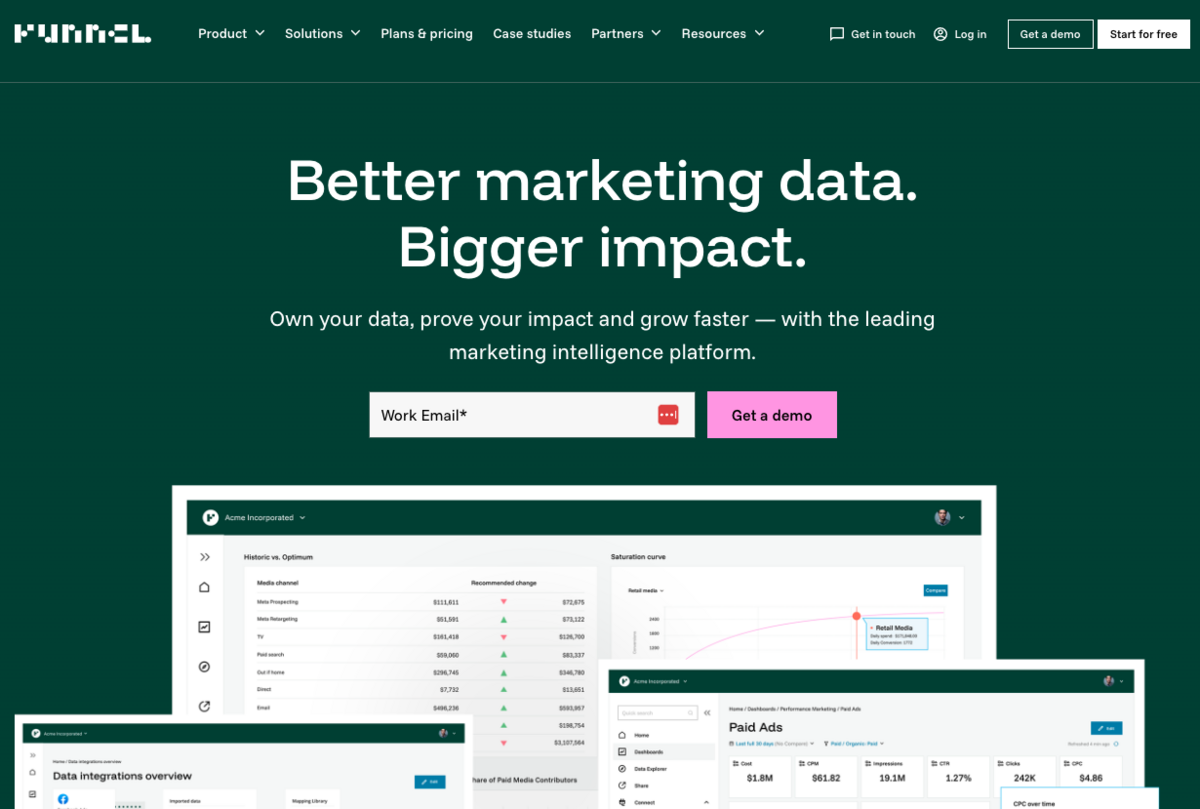
Funnel helps marketing teams turn scattered performance data into something they can actually use. It’s a comprehensive Marketing Intelligence Platform that handles data integration, transformation, measurement and reporting at scale. Funnel pulls from over 500 platforms, then gives users control over how that data is grouped, named and measured — without needing SQL or custom scripts.
Once connected, you can:
- Clean and normalize inconsistent naming across platforms
- Create custom metrics that match your internal goals
- Map campaign structures across tools like Google Ads and LinkedIn
- Set up exports to Google Sheets, Looker Studio, Power BI or BigQuery
- Keep everything up to date automatically, no re-uploads needed
This setup works especially well for teams that manage multiple brands or channels and need numbers to line up without a bunch of patchwork fixes.
Instead of working inside disconnected dashboards, Funnel lets you shape your data first, so when it lands in a report, it already makes sense. Naming conventions are automated, so data is consistent and ready for analysis. That’s useful when you need to explain spend fluctuations, compare campaign types or prep data for client-facing reports.
It’s a strong fit for agencies and in-house teams that don’t want to rebuild their reporting logic every time a campaign launches or a new platform gets added.
For agencies managing client reporting, Funnel’s Portals feature makes sharing dashboards secure and polished. You can brand the portal with a logo and color scheme, add multiple dashboards and invite clients as viewers.
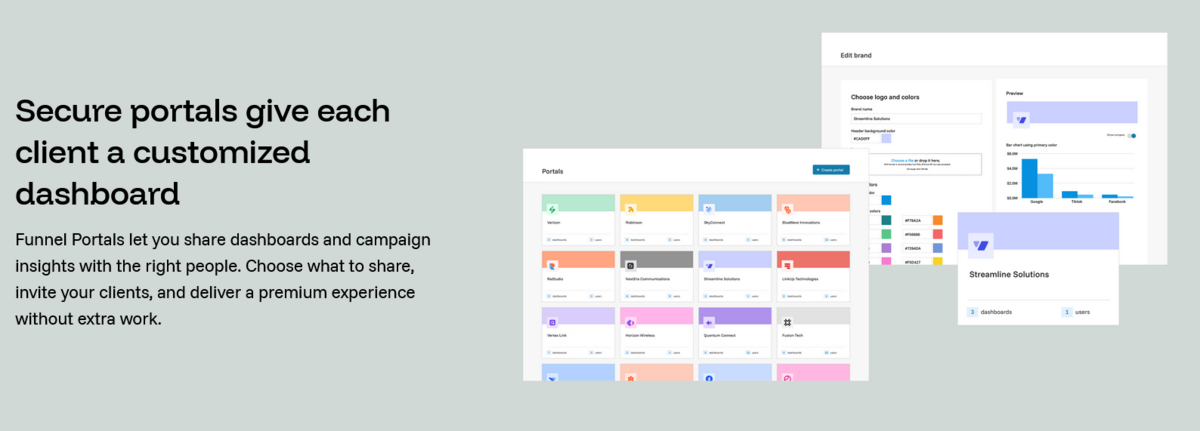
Clients don’t need Funnel accounts — just a login to view filtered dashboards. It’s a more professional alternative to email attachments or link sharing, and it’s fully integrated into Funnel’s existing dashboard tools for easy access management and usage tracking.
How Funnel compares to DashThis
DashThis is built for simple campaign reporting — quick dashboards, basic exports and preset metrics. Funnel does that too, but it adds full control over marketing data. You get hundreds of fully-managed connectors, data transformation so you’re always comparing apples to apples, customization flexibility and automatic exports to BI tools like BigQuery and Power BI. DashThis supports PDFs and Sheets only.
Funnel streamlines integration and gives you analysis-ready data you can trust, making it a reliable option for growing teams. You also won’t need to switch to an enterprise solution if your marketing intelligence requirements become more demanding down the road, as you can upgrade to access advanced modeling, scenario planning and AI-powered analytics for more complex data needs.
2. AgencyAnalytics
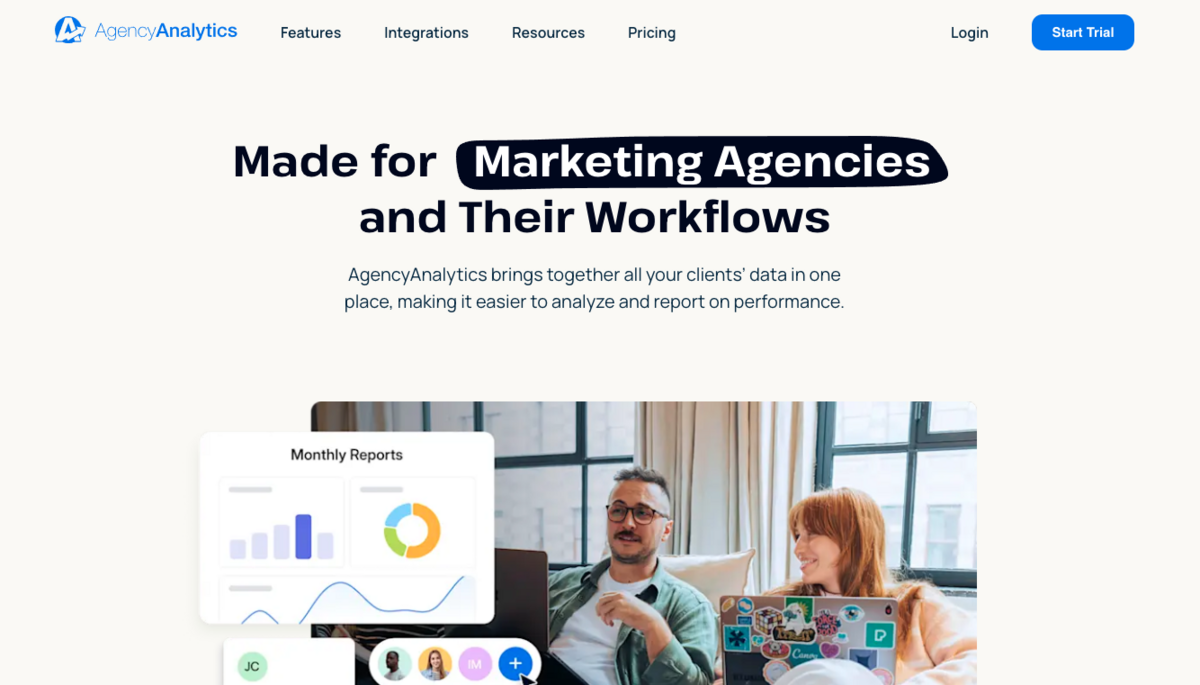
AgencyAnalytics is purpose-built for marketing agencies reporting across multiple clients. It comes with prebuilt templates for SEO, PPC, email marketing and social, so you can launch dashboards quickly without starting from scratch.
The platform includes client login portals, white label options and a task management system to keep campaigns on track. Built-in annotations make it easy to explain shifts in performance without needing a separate email or call.
It’s a solid fit for account managers who need clear, hands-off reporting with just enough flexibility to match how their agency operates. However, the dashboards are widget-based with limited blending, which can cause problems fast if you’re trying to learn more than the basics from your data.
How AgencyAnalytics compares to DashThis
DashThis is built for quick, clean dashboards, but that’s where it stops. AgencyAnalytics adds features agencies actually use day to day — like assigning tasks to team members, letting clients log in to check reports and adding context with annotations. These extras help teams stay organized and reduce back-and-forth, which is critical when managing multiple clients at once.
3. Adverity
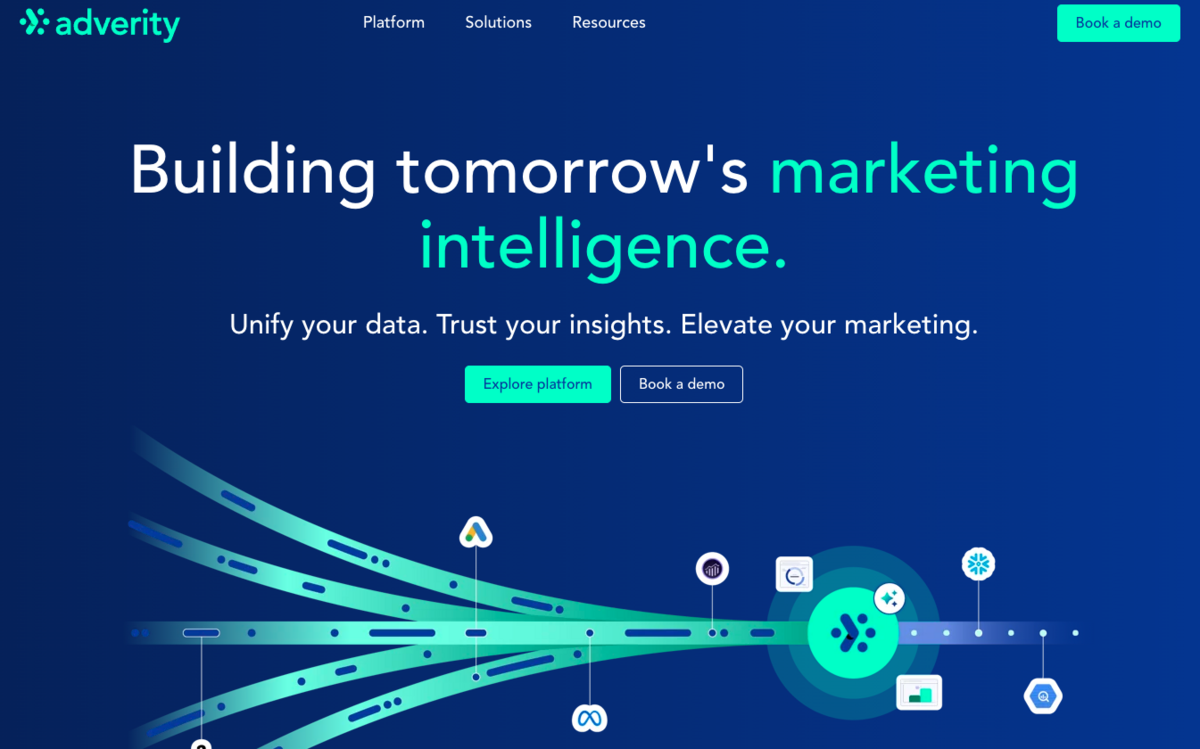
Adverity is a data integration platform built for technical teams handling large-scale, multi-channel marketing data. It’s not designed for marketers — it’s for analysts and BI teams who need full control over how data is collected, shaped and delivered.
The platform supports ETL workflows, custom pipelines, anomaly detection and flexible data transformations. You can connect dozens of platforms, normalize inputs and send that data to warehouses or visualization tools.
It’s ideal for enterprise teams that already work inside complex analytics environments and want to centralize marketing performance data without building infrastructure from scratch. Adverity is slower to onboard and slower to value than marketing intelligence platforms like Funnel, which offers a no-code interface that lets marketers self-serve data movement.
How Adverity compares to DashThis
DashThis is a fast and user-friendly reporting tool, but rigid. Adverity is more focused on data pipelines than other marketing data needs, and it’s built for technical users. If you need fast setup and templates, go with DashThis. If you need to model complex data for internal reporting, Adverity fits better.
4. Improvado
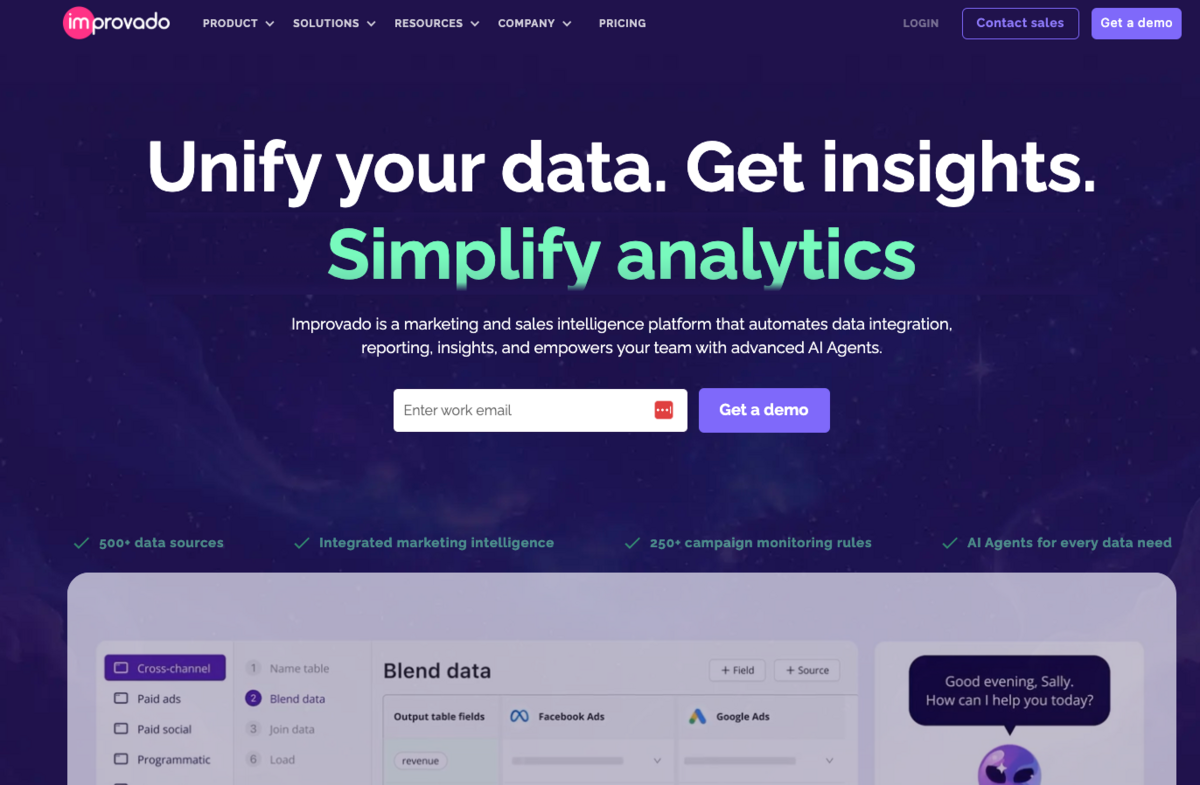
Improvado is built for in-house teams managing large budgets across multiple marketing and sales channels. It focuses on data integration and pipeline control, not just visualization.
You can build custom pipelines, connect dozens of platforms and define your own metrics. Improvado also supports revenue tracking, cross-channel attribution and AI tools to speed up reporting tasks. It's especially useful for aligning marketing and sales data without relying on engineering support.
Setup takes more time than a plug-and-play dashboard, but teams get more control over how data is structured and where it goes.
How Improvado compares to DashThis
DashThis is faster to set up, but it’s limited to predefined layouts. Improvado supports deeper customization, pipeline automation and revenue attribution. It’s a better fit for teams that outgrow templates and need a reporting workflow built around their data, not the other way around.
5. Supermetrics
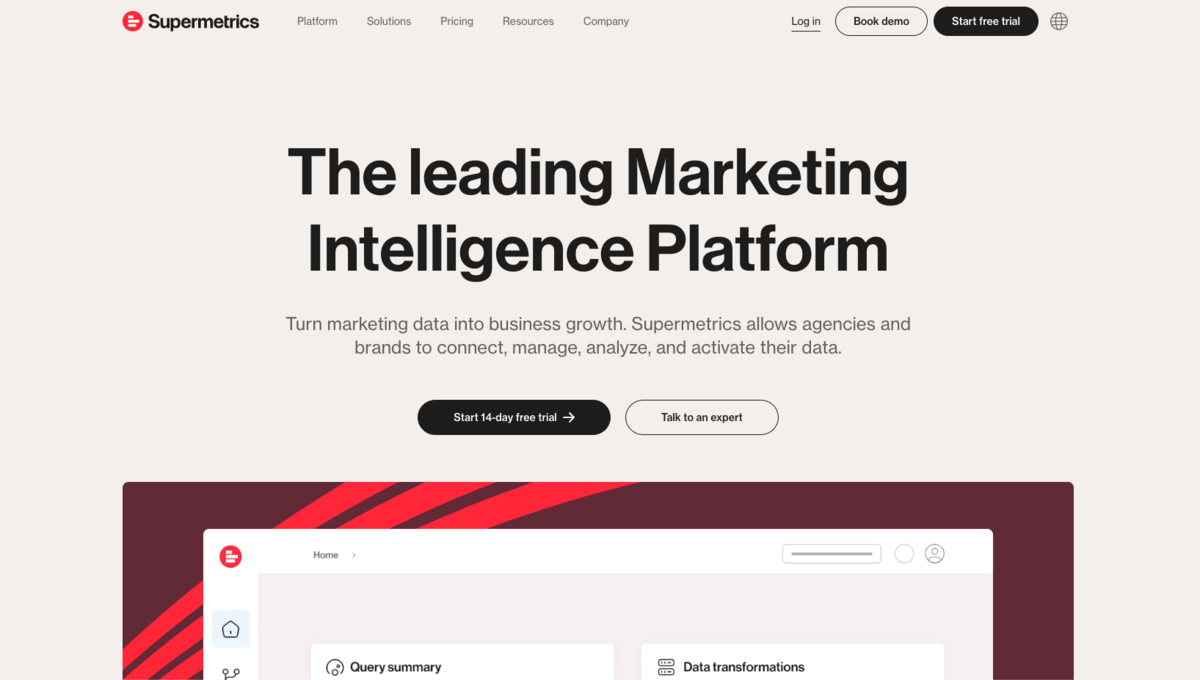
Supermetrics is a data pipeline tool for marketers who want control over where their data goes and how it's structured. It’s commonly used by performance teams and agencies that prefer building reports in Google Sheets, Looker Studio or BigQuery.
The platform supports hundreds of connectors and pre-load data transformations. But it doesn’t offer built-in visuals or dashboards — you’ll need to set up reports separately in your tool of choice. Supermetrics also lacks measurement tools, and its marketing intelligence cloud is relatively new when compared to more developed features like Funnel’s Data Hub.
Supermetrics is best suited for teams with analytics resources or technical experience. Setting it up and maintaining it requires comfort with query tools, custom metrics and SQL.
How Supermetrics compares to DashThis
DashThis is easier to launch and handles visuals by default. Supermetrics is more hands-on and better for teams that want raw, SQL-ready data delivered to their warehouse or reporting tool. It has a steep learning curve, so teams that want to start playing with their data right away might be better served by a platform with a faster time to value.
6. Klipfolio
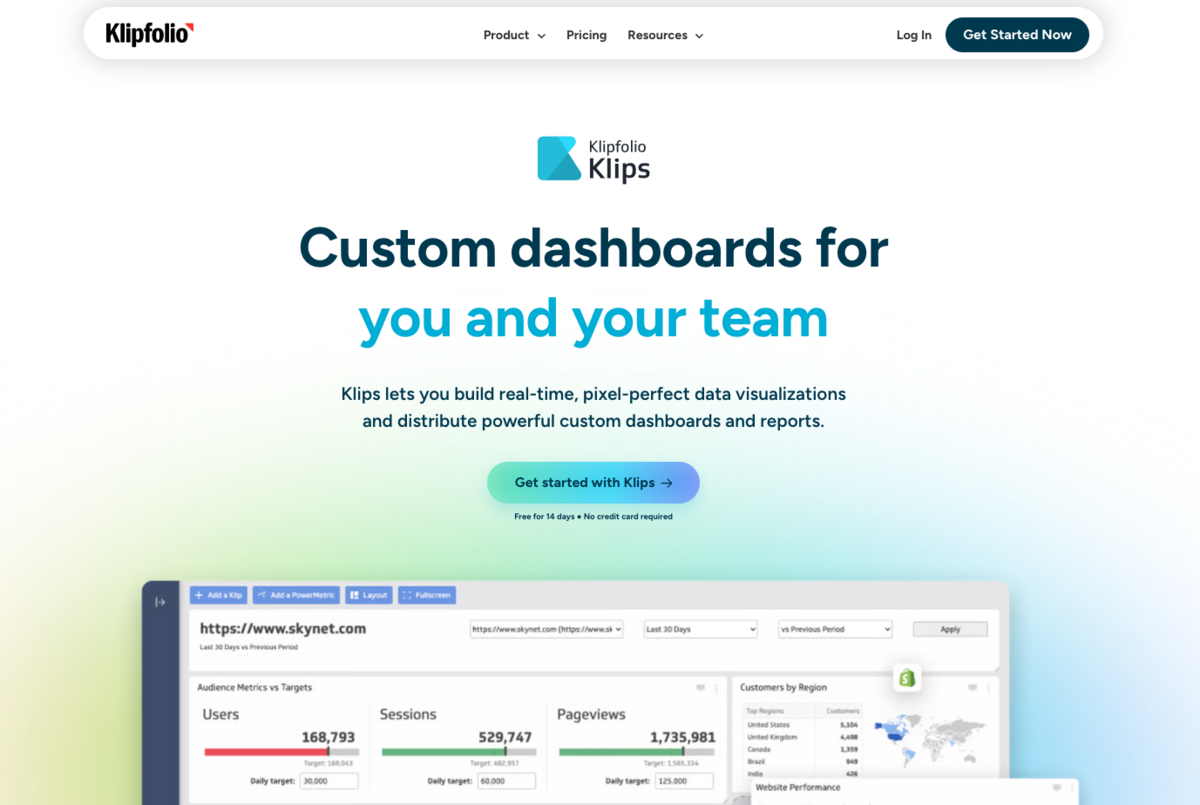
Klipfolio is a dashboard tool for teams that want total control over how reports look and behave. It’s popular with marketers who are comfortable building from scratch and want to design highly customized layouts.
The platform supports real-time data updates, custom metrics and advanced visualizations. You can drag and drop elements, tweak formatting and layer in calculated fields. But with that flexibility comes a learning curve — expect some setup time before things click.
Klipfolio is a good fit for teams that care more about presentation detail than ease of setup.
How Klipfolio compares to DashThis
DashThis is plug-and-play with fixed templates. Klipfolio requires more effort but gives you more control. It’s better for teams that want to design dashboards around their data, not the other way around. DashThis wins on speed; Klipfolio wins on precision.
7. Databox
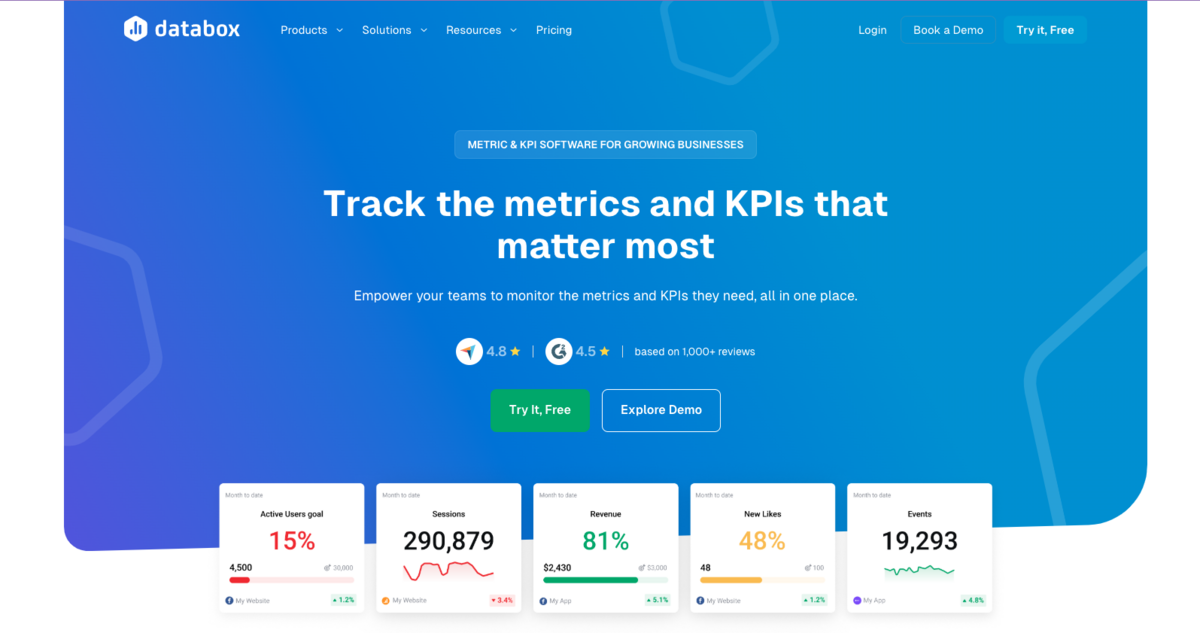
Databox is a dashboard platform built for teams that want to track performance goals and share clean, mobile-friendly reports. It connects to hundreds of tools, including HubSpot, Google Analytics, Facebook Ads and more.
You can use prebuilt templates to launch dashboards quickly or customize layouts using their drag-and-drop editor. The platform also supports KPI tracking, daily scorecards and alert systems. These features are helpful for teams that want to monitor progress without checking spreadsheets.
Databox is useful for client-facing teams who need simple, polished visuals that are ready to present to stakeholders.
How Databox compares to DashThis
DashThis gets you a working dashboard slightly faster, but Databox delivers more polish and structure for goal tracking. Databox includes mobile-friendly layouts, built-in KPI goals and automated alerts — features DashThis doesn’t support. It’s a better fit when presentation and progress tracking matter most.
8. Tableau
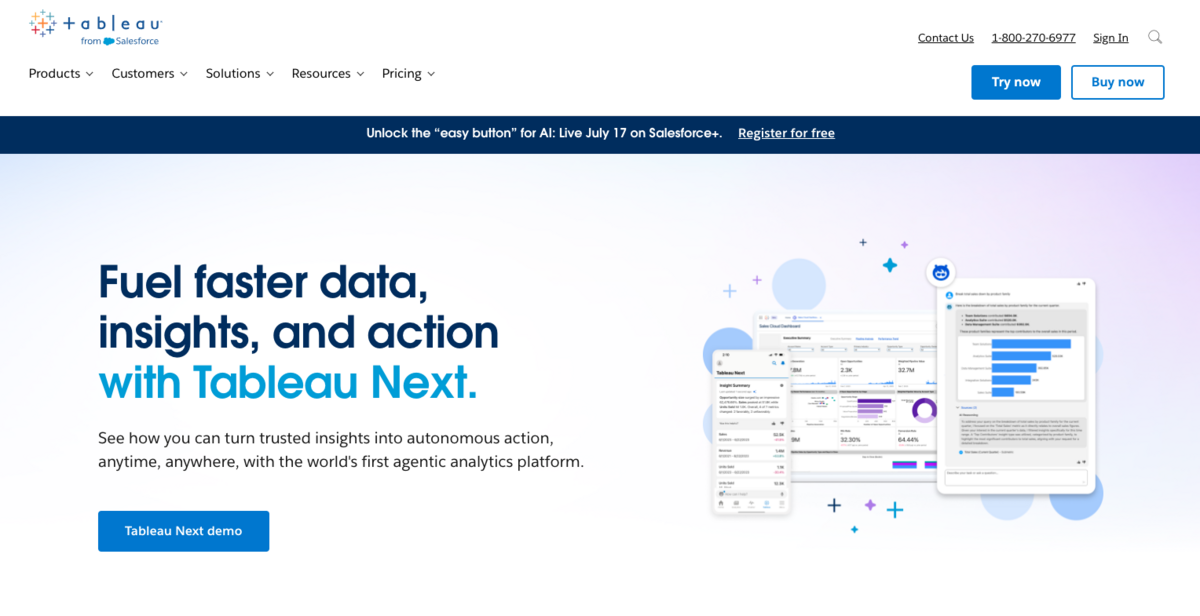
Tableau is a business intelligence platform used by data analysts and enterprise teams with advanced reporting needs. It connects to nearly any data source and supports custom queries, calculated fields, forecasting and filtering.
Users can build detailed dashboards, blend data from multiple platforms and explore metrics interactively. It’s powerful, but not built for beginners. Teams without technical experience may struggle with setup and maintenance. Funnel makes working with Tableau a little easier by preparing analysis-ready data and sharing it automatically with Tableau.
Tableau works best for organizations that already have BI infrastructure or access to analytics support.
How Tableau compares to DashThis
DashThis is easier to pick up and better suited for marketers who want quick dashboards with minimal setup. Tableau is more flexible and far more powerful, but also more demanding. If you need to build complex reports that combine multiple data sources, Tableau is a better long-term option.
Why Funnel is the best DashThis alternative
DashThis is a solid reporting tool for basic dashboards and automated reports. But once your team starts working across multiple platforms, managing different naming conventions or tracking advanced metrics, its limitations show.
Funnel gives marketing teams full control over how they collect, transform and organize their marketing data. With over 500 connectors and support for custom integrations, you can pull data from every major marketing platform automatically, including Google Ads, LinkedIn Ads and email marketing tools.
You can map data across channels, apply currency conversions, standardize date formats and build calculated fields that reflect your business needs. Funnel becomes the layer between your data sources and reporting tools, making sure your numbers are accurate before they hit a dashboard.
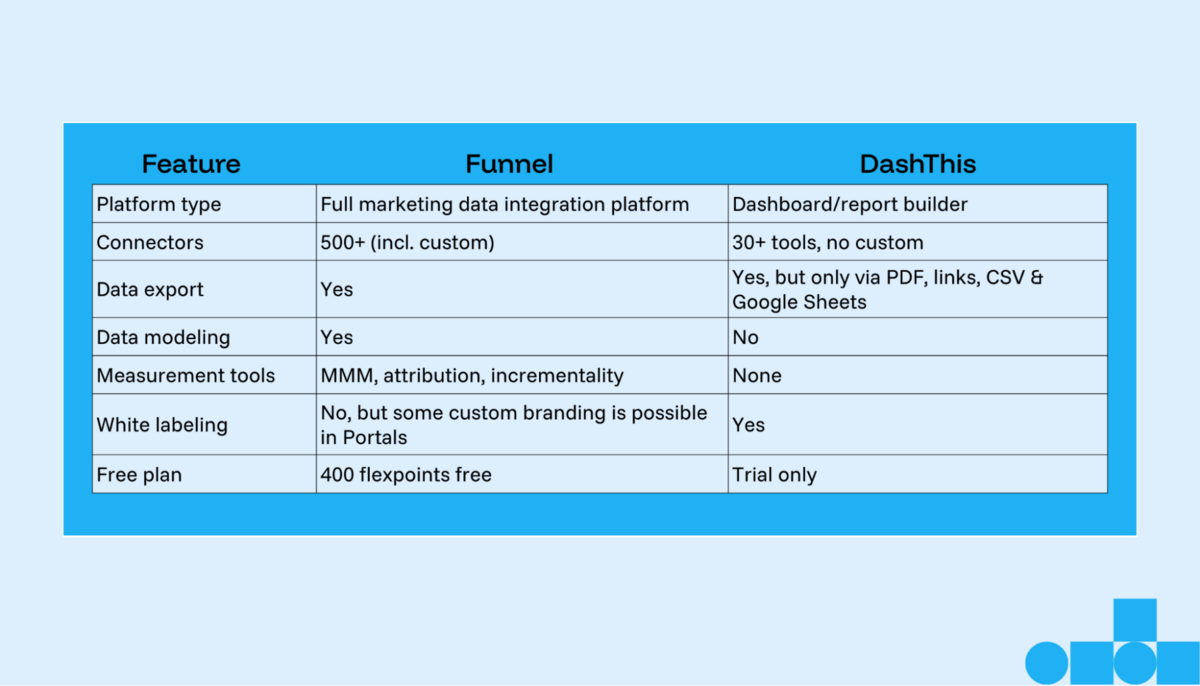
Exports aren’t limited to PDFs or Google Sheets. Funnel sends structured data directly to BI tools like Looker Studio and Tableau or cloud destinations like BigQuery. It also supports advanced measurement, including marketing mix modeling (MMM), attribution and incrementality testing — features DashThis doesn’t offer.
Ready to move beyond basic dashboards? Funnel gives you a single source of truth to report, measure and grow with confidence. Sign up now to get started.
DashThis alternatives FAQs
Still deciding whether DashThis or one of its competitors fits your team best? Here’s a breakdown of common questions teams ask when comparing tools.
How much is DashThis?
DashThis starts at $33 per month (billed annually) for three dashboards. Higher pricing tiers unlock more dashboards and allow for additional users. Each plan comes with standard features like scheduled reports, basic templates and platform integrations. If you’re looking for a platform with more flexible pricing, explore Funnel’s plans, which range from a free start to enterprise-level.
What’s the best DashThis alternative for marketing agencies?
Funnel is one of the best DashThis alternatives for marketing agencies. It’s built to handle high volumes of marketing data across multiple accounts. Instead of just creating dashboards, Funnel automates data collection, applies transformations and delivers accurate, up-to-date client reports at scale.
Agencies can organize their data using separate workspaces for each client and invite unlimited users at no extra cost. With the Portals feature, they can securely share branded dashboards — complete with logos and custom colors — giving clients a polished experience without needing Funnel accounts. This makes collaboration easier and keeps everyone aligned without relying on spreadsheets or static PDF attachments.
Can you export data from DashThis?
Yes, but with limitations. DashThis allows PDF exports and dashboard link sharing. You can also download CSV files from certain widgets. However, raw data access is minimal, and there’s no support for full data pipelines or BI tool exports like BigQuery or Power BI.
For teams that need advanced data destinations or regular syncs with Google Sheets or Looker Studio, a platform like Funnel offers more flexibility and control over how your data flows.
Do any DashThis alternatives offer AI-powered insights?
Yes, a few DashThis alternatives offer AI features. Adverity includes anomaly detection and forecasting. Improvado is building AI agents to speed up reporting. Databox generates summaries and alerts for templated dashboards and reports.
-
Written by Christopher Van Mossevelde
Head of Content at Funnel, Chris has 20+ years of experience in marketing and communications.
